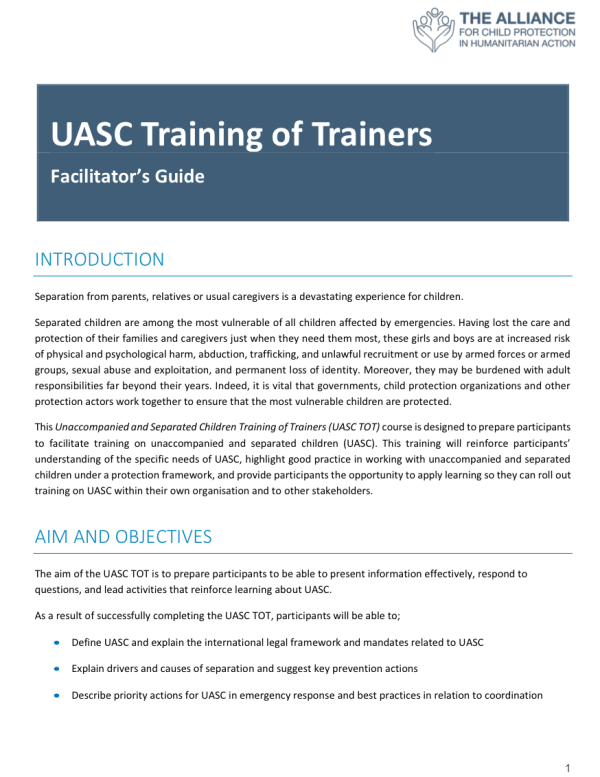
Training of Trainers | Unaccompanied and Separated Children
*Note: Please get in touch with the L&D Working Group (learning@alliancecpha.org) if you are planning to using this package for feedback gathering purposes. Thank you.
In 2018, the Alliance’s Unaccompanied and Separated Children (UASC) Task Force, led at the time by IOM and UNHCR, developed and subsequently piloted a first UASC Training of Trainers package based on thematic interagency guidance.
In 2023, building on lessons learnt from the pilots, on trends and developments in terms of UASC programming, the UASC TF undertook an exhaustive revision of the UASC ToT. The reshuffled and updated product is designed to clearly reflect the Alliance approach to prevention of separation, linkages with case management, and information management for case management, and the provision of alternative care. Having taken stock of the constraints during the COVID-19 pandemic, the package also includes guidance on remote delivery and adult learning. Numerous agencies contributed time and expertise to this UNICEF-led initiative.
The Unaccompanied and Separated Children Training of Trainers (UASC TOT) course is therefore designed to prepare participants to facilitate training on unaccompanied and separated children (UASC). This training will reinforce participants’ understanding of the specific needs of UASC, highlight good practice in working with unaccompanied and separated children under a protection framework, and provide participants the opportunity to apply learning so they can roll out training on UASC within their own organisation and to other stakeholders.
Aim and Objectives:
The aim of the UASC TOT is to prepare participants to be able to present information effectively, respond to questions, and lead activities that reinforce learning about UASC.
As a result of successfully completing the UASC TOT, participants will be able to;
- Define UASC and explain the international legal framework and mandates related to UASC
- Explain drivers and causes of separation and suggest key prevention actions
- Describe priority actions for UASC in emergency response and best practices in relation to coordination
- Describe how to conduct identification and other case management steps for UASC
- Describe alternative care best practices in emergencies
- Explain the process of family tracing, reunification, reintegration, and follow up for UASC
This training is aligned to the Field Handbook on Unaccompanied and Separated Children and the Addendum to the Field Handbook on Unaccompanied and Separated Children. Participants will be directed to relevant material from the Toolkit on Unaccompanied and Separated Children, the Primary Prevention Framework for Child Protection in Humanitarian Action, 2019 Minimum Standards for Child Protection in Humanitarian Action, the Child Protection in Humanitarian Action Competency Framework, and the Alternative Care in Emergencies Toolkit.

